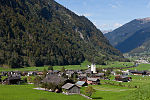Chüebodensee
Canton of Glarus geography stubsLakes of SwitzerlandLakes of the canton of GlarusLinth/Limmat basinSwitzerland lake stubs

Chüebodensee is a lake above Elm in the Canton of Glarus, Switzerland. Its surface area is 1.4 ha. There are about 8 km of well established trails around the lake. The lake is within the Glarner Freiberg wildlife preserve. The lake can be reached from Elm by taking the Elm-Ämpächli gondola to Ämpächlialp and hiking over well marked trails. The trip from Ämpächlialp to the lake and back will generally take about 4 hours.
Excerpt from the Wikipedia article Chüebodensee (License: CC BY-SA 3.0, Authors, Images).Chüebodensee
Wald, Glarus Süd
Geographical coordinates (GPS) Address Nearby Places Show on map
Geographical coordinates (GPS)
| Latitude | Longitude |
|---|---|
| N 46.936388888889 ° | E 9.1344444444444 ° |
Address
Chüebodensee
Wald
8767 Glarus Süd
Glarus, Switzerland
Open on Google Maps







